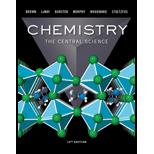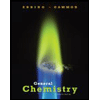
Chemistry: The Central Science Plus Mastering Chemistry with Pearson eText -- Access Card Package (14th Edition)
14th Edition
ISBN: 9780134292816
Author: Theodore E. Brown, H. Eugene LeMay, Bruce E. Bursten, Matthew E. Stoltzfus
Publisher: PEARSON
expand_more
expand_more
format_list_bulleted
Concept explainers
Textbook Question
Chapter 6, Problem 108IE
- Account for formation of the following series of oxides in terms of the electron configurations of the elements and the discussion of ionic compounds in Section 2.7 GI:
K2O, CaO, Sc2O3, Ti02, V205, CrO3.
| Oxide | K20(s) | Ca0(s) | Ti02(s) | V205(s) |
| Alff | -363.2 | -635.1 | -938.7 | -1550.6 |
Calculate the enthalpy changes in the following general reaction for each case:
MnOm(s) + H2(g) ->nM(s) + mH2O(g)
(You will need to write the balanced equation for each case and then compute ΔH°. )(d) Based on the data given, estimate a value ofΔHf ° for Sc203(s).
Expert Solution & Answer
Want to see the full answer?
Check out a sample textbook solution
Students have asked these similar questions
Come and compare the Bronsted-Bjerrum calculation, the Debye and Hückel calculation, and the Davies calculation.
plz watch the youtube video (the title of this topic) by roxi H. she explains it step by step but i get the wrong answer
Writing the rate law implied by a simple mechanism
To exit full screen, press and hold esc
Suppose the decomposition of ozone proceeds by the following mechanism:
step
elementary reaction
rate constant
1
→>>
O3(9) O2(g) + O(g)
k₁
2
03(g) + O(g)
→
202(g)
k2
Suppose also k₁ »k2. That is, the first step is much faster than the second.
Write the balanced
chemical equation for the
overall chemical reaction:
Write the experimentally-
observable rate law for the
overall chemical reaction.
☐
rate
=
☐
Note: your answer should
not contain the
concentrations of any
intermediates.
Express the rate constant
k for the overall chemical
reaction in terms of K1, K2,
and (if necessary) the rate
constants k-1 and K-2 for
the reverse of the two
elementary reactions in
the mechanism.
k =
☐
000
18
ローロ
Ar
OO
Chapter 6 Solutions
Chemistry: The Central Science Plus Mastering Chemistry with Pearson eText -- Access Card Package (14th Edition)
Ch. 6.1 - A source of electromagnetic radiation produces...Ch. 6.1 - Which type of visible light has a longer...Ch. 6.1 - Consider the following three statements: For any...Ch. 6.1 - A laser used in orthopedic spine surgery produces...Ch. 6.2 - Prob. 6.3.1PECh. 6.2 -
A laser emits light that has a frequency of 4.69...Ch. 6.3 - Prob. 6.4.1PECh. 6.3 -
For each of the following transitions, give the...Ch. 6.4 - Consider the following three moving objects: a...Ch. 6.4 - Calculate the velocity of a neutron whose de...
Ch. 6.5 - An orbital has n = 4 and ml = 0, 1, 2, 3 -3, - 2,...Ch. 6.5 -
What is the designation for the subshell with = 5...Ch. 6.8 - How many of the elements in the second row of the...Ch. 6.8 - Write the electron configuration for silicon,...Ch. 6.9 - A certain atom has an ns2np2electron configuration...Ch. 6.9 -
Which group of elements is characterized by an...Ch. 6.9 -
A certain atom has a [noble gas]5s24d105p4...Ch. 6.9 - Prob. 6.9.2PECh. 6 - In this chapter, we have learned about the...Ch. 6 - The speed of sound in dry air at 20°C is 343 m/s...Ch. 6 -
6.2 A popular kitchen appliance produces...Ch. 6 - 6.3 The following diagrams represent two...Ch. 6 -
6.4 Stars do not all have the same temperature....Ch. 6 - 6 5 The familiar phenomenon of a rainbow results...Ch. 6 -
6.7 A certain quantum mechanical system has the...Ch. 6 - Consider the three electronic transitions in a...Ch. 6 - Prob. 8ECh. 6 -
6.9 The contour representation of one of the...Ch. 6 -
6.10 The accompanying drawing shows a contour...Ch. 6 -
8.11 Four possible electron configurations for a...Ch. 6 -
6.12 State where in the periodic table these...Ch. 6 - Prob. 13ECh. 6 -
6.14
a What is the relationship between the...Ch. 6 - Label each of the following statements as true or...Ch. 6 - Determine which of the following statements are...Ch. 6 - Arrange the following kinds of electromagnetic...Ch. 6 - List the following types of electromagnetic...Ch. 6 - What is the frequency of radiation that has a...Ch. 6 - What is the frequency of radiation whose...Ch. 6 - A laser pointer used in a lecture hall emits light...Ch. 6 - It is possible to convert radiant energy into...Ch. 6 - If human height were quantized in 1-foot...Ch. 6 - Einstein's 1905 paper on the photoelectric effect...Ch. 6 - Calculate the energy of a photon of...Ch. 6 - Prob. 26ECh. 6 - Prob. 27ECh. 6 - An AM radio station broadcasts at 1010 kHz, and...Ch. 6 - One type of sunburn occurs on exposure to UV light...Ch. 6 - Prob. 30ECh. 6 - Prob. 31ECh. 6 - A stellar object is emitting radiation at 3.55 mm....Ch. 6 - Molybdenum metal must absorb radiation with a...Ch. 6 - Titanium metal requires a photon with a minimum...Ch. 6 - Prob. 35ECh. 6 - Classify each of the following statements as...Ch. 6 - Prob. 37ECh. 6 -
6 38 Indicate whether energy is emitted or...Ch. 6 - Using Equation 6.5. calculate the energy of an...Ch. 6 - Prob. 40ECh. 6 - The visible emission lines observed by Balmer all...Ch. 6 - Prob. 42ECh. 6 - Prob. 43ECh. 6 - The hydrogen atom can absorb light of wavelength...Ch. 6 - Prob. 45ECh. 6 - Prob. 46ECh. 6 - Use the de Brogue relationship to determine the...Ch. 6 - Prob. 48ECh. 6 - Neutron diffraction is an important technique for...Ch. 6 - The electron microscope has been widely used to...Ch. 6 - Using Heisenberg's uncertainty principle,...Ch. 6 - Prob. 52ECh. 6 - Classify the following statements as either true...Ch. 6 - 0 1 2 3 4 5 6 7 8 9 10 Distance from the nucleus,...Ch. 6 - Prob. 55ECh. 6 - Prob. 56ECh. 6 - Prob. 57ECh. 6 - Give the values for n, I,and mlfor each orbital in...Ch. 6 - Prob. 59ECh. 6 - Prob. 60ECh. 6 - Which of the following represent impossible...Ch. 6 - For the table that follows, write which orbital...Ch. 6 - Sketch the shape and orientation of the following...Ch. 6 - Prob. 64ECh. 6 - Prob. 65ECh. 6 - Prob. 66ECh. 6 - Prob. 67ECh. 6 - Prob. 68ECh. 6 - Two possible electron configurations for an Li...Ch. 6 -
6.70 An experiment called the Stern—Gerlach...Ch. 6 - Prob. 71ECh. 6 - Prob. 72ECh. 6 - What are "valence electrons"? What are "core...Ch. 6 - For each element, indicate the number of valence...Ch. 6 - Write the condensed electron configurations for...Ch. 6 - Write the condensed electron configurations for...Ch. 6 - Identify the specific element that corresponds to...Ch. 6 - Identify the group of elements that corresponds to...Ch. 6 - The following do not represent valid ground-state...Ch. 6 - Prob. 80ECh. 6 - Prob. 81AECh. 6 - Prob. 82AECh. 6 - Prob. 83AECh. 6 - Prob. 84AECh. 6 - Prob. 85AECh. 6 - Prob. 86AECh. 6 - Prob. 87AECh. 6 - In an experiment to study the photoelectric...Ch. 6 - Prob. 89AECh. 6 - Prob. 90AECh. 6 - Prob. 91AECh. 6 - Prob. 92AECh. 6 - Prob. 93AECh. 6 - Prob. 94AECh. 6 - Prob. 95AECh. 6 - Prob. 96AECh. 6 - Prob. 97AECh. 6 - Prob. 98AECh. 6 - Prob. 99AECh. 6 - [6.100] The Chemistry and Life box in Section 6.7...Ch. 6 - Prob. 101AECh. 6 - Using the periodic table as a guide, write the...Ch. 6 - Prob. 103AECh. 6 - [6.104] In the experiment shown schematically...Ch. 6 - Microwave ovens use microwave radiation to heat...Ch. 6 - Prob. 106IECh. 6 - The discovery of hafnium, element number 72,...Ch. 6 - Account for formation of the following series of...Ch. 6 - Prob. 109IECh. 6 - The two most common isotopes of uranium are 235U...
Knowledge Booster
Learn more about
Need a deep-dive on the concept behind this application? Look no further. Learn more about this topic, chemistry and related others by exploring similar questions and additional content below.Similar questions
- Deducing a rate law from the change in concentration over time To exit full screen, press and hold esc A chemistry graduate student is studying the rate of this reaction: H2CO3(aq) → H₂O(aq) +CO₂ (aq) - She fills a reaction vessel with H2CO3 and measures its concentration as the reaction proceeds: time (milliseconds) [H2CO3] 0 0.0500 M 10. 0.0266M 20. 0.0181 M 30. 0.0138M 40. 0.0111 M Use this data to answer the following questions. Write the rate law for this reaction. Calculate the value of the rate constant k. Round your answer to 2 significant digits. Also be sure your answer has the correct unit symbol. rate ☐ x10 k = Х 000 18 Ararrow_forwardWriting the rate law implied by a simple mechanism Suppose the formation of tert-butanol proceeds by the following mechanism: step elementary reaction 1 (CH3)3 CBr(aq) → (CH3)2 C* (aq) + Br (aq) 2 (CH3)2C (aq) + OH¯ (aq) → (CH3)2COH(aq) rate constant k₁ k₂ Suppose also k₁ »k2. That is, the first step is much faster than the second. Write the balanced chemical equation for the overall chemical reaction: Write the experimentally- observable rate law for the overall chemical reaction. Note: your answer should not contain the concentrations of any intermediates. rate = k ☐ Express the rate constant k for the overall chemical reaction in terms of K1, K2, and (if necessary) the rate constants k-1 and K-2 for the reverse of the two elementary reactions in the mechanism. k = ☐ □ ☑ G ? 00. 18 Ar Barrow_forwardDeducing a rate law from the change in concentration over time A chemistry graduate student is studying the rate of this reaction: 2SO3 (g) →>> 2SO2 (g) + O2(g) He fills a reaction vessel with SO3 and measures its concentration as the reaction proceeds: ? time (minutes) [SO3] 0 0.0200M 1.0 0.0105 M 2.0 0.00552M 3.0 0.00290M 4.0 0.00152M Use this data to answer the following questions. Write the rate law for this reaction. rate = k ☐ x10 Calculate the value of the rate constant k. Round your answer to 2 significant digits. Also be sure your answer has the correct unit symbol. k = ☐ Х 000 18 Ar BAarrow_forward
- Using the Arrhenius equation to calculate k at one temperature from k at... The rate constant of a certain reaction is known to obey the Arrhenius equation, and to have an activation energy E reaction is 1.2 × 107 M −1 .S at 160.0 °C, what will the rate constant be at 194.0 °C? Round your answer to 2 significant digits. k = Шм −1 -1 .S ☐ x10 ☑ 5 = = 16.0 kJ/mol. If the rate constant of this a ? olo Ar Barrow_forwardUsing the Arrhenius equation to calculate k at one temperature from k at... a The rate constant of a certain reaction is known to obey the Arrhenius equation, and to have an activation energy E = 10.0 kJ/mol. If the rate constant of this reaction is 9.9 × 107 M -1 .S at 246.0 °C, what will the rate constant be at 196.0 °C? Round your answer to 2 significant digits. k = ☐ M -1 −1 .S x10 ☑ ? 00. 18 Ar Barrow_forwardWriting the rate law implied by a simple mechanism Suppose the reaction between nitric oxide and bromine proceeds by the following mechanism: elementary reaction - NO(g) + Br2(g) → NOBг2(g) step 1 2 NOBг2(g) + NO(g) - rate constant k₁ 2 NOBr(g) k2 Suppose also k₁ »k2. That is, the first step is much faster than the second. Write the balanced chemical equation for the overall chemical reaction: Write the experimentally- observable rate law for the overall chemical reaction. Note: your answer should not contain the concentrations of any intermediates. ☐ rate = k Express the rate constant k for the overall chemical reaction in terms of k₁, k2, and (if necessary) the rate constants k-1 and K-2 for the reverse of the two elementary reactions in the mechanism. = ☐ ロ→ロ Х ك ? 000 18 Ararrow_forward
- Deducing a rate law from the change in concentration over time chemistry graduate student is studying the rate of this reaction: 2H3PO4 (aq) → P₂O5 (aq) +3H₂O (aq) 2 e fills a reaction vessel with H3PO and measures its concentration as the reaction proceeds: 4 time (seconds) [H3PO4] 0 0.500M 1.0 0.229 M 2.0 0.148M 3.0 0.110M 4.0 0.0871 M se this data to answer the following questions. Write the rate law for this reaction. rate = k x10 Calculate the value of the rate constant k. k = Round your answer to 2 significant digits. Also be sure your answer has the correct unit symbol. ☑ G olo 18 Ararrow_forwardWriting the rate law implied by a simple mechanism Suppose the formation of nitrosyl chloride proceeds by the following mechanism: elementary reaction step rate constant 1 NO(g) + Cl2(g) → NOC₁₂(g) k₁ 2 NOCl2(g) + NO(g) 2 NOCl(g) →>> k2 Suppose also k₁ »k. That is, the first step is much faster than the second. Write the balanced chemical equation for the overall chemical reaction: Write the experimentally- observable rate law for the overall chemical reaction. rate = k ☐ Note: your answer should not contain the concentrations of any intermediates. Express the rate constant k for the overall chemical reaction in terms of K1, K2, and (if necessary) the rate constants k-1 and K-2 for the reverse of the two elementary reactions in the mechanism. k = | Х ? 18 Ararrow_forwardUsing first- and second-order integrated rate laws 1/5 Consider this reaction: H2CO3(aq) → H₂O (aq) +CO₂ (aq) At a certain temperature it obeys this rate law. rate = (2.27 s¹) [H2CO3] Suppose a vessel contains H2CO3 at a concentration of 0.830M. Calculate how long it takes for the concentration of H2CO3 to decrease by 83.0%. You may assume no other reaction is important. Round your answer to 2 significant digits. S x10 ☑ § ? 00. 18 Ararrow_forward
- Using the Arrhenius equation to calculate k at one temperature from k at... Try Again Your answer is incorrect. 0/5 a The rate constant of a certain reaction is known to obey the Arrhenius equation, and to have an activation energy E = 28.0 kJ/mol. If the rate constant of this -1 -1 reaction is 2.5 × 10³ M ·S at 45.0 °C, what will the rate constant be at 104.0 °C? Round your answer to 2 significant digits. ST -1 -1 ☐ x10 k = 2.8 × 10 - M .S 18 Ararrow_forwardIn the theory of the state of transition, indicate the expression of the constant k in function of deltaE0#. This expression is also the ecuation of Arrhenius?arrow_forwardBriefly indicate the differences between Ea of the theory of collisions and E0# the theory of the state of transition.arrow_forward
arrow_back_ios
SEE MORE QUESTIONS
arrow_forward_ios
Recommended textbooks for you
 Chemistry: The Molecular ScienceChemistryISBN:9781285199047Author:John W. Moore, Conrad L. StanitskiPublisher:Cengage Learning
Chemistry: The Molecular ScienceChemistryISBN:9781285199047Author:John W. Moore, Conrad L. StanitskiPublisher:Cengage Learning General Chemistry - Standalone book (MindTap Cour...ChemistryISBN:9781305580343Author:Steven D. Gammon, Ebbing, Darrell Ebbing, Steven D., Darrell; Gammon, Darrell Ebbing; Steven D. Gammon, Darrell D.; Gammon, Ebbing; Steven D. Gammon; DarrellPublisher:Cengage Learning
General Chemistry - Standalone book (MindTap Cour...ChemistryISBN:9781305580343Author:Steven D. Gammon, Ebbing, Darrell Ebbing, Steven D., Darrell; Gammon, Darrell Ebbing; Steven D. Gammon, Darrell D.; Gammon, Ebbing; Steven D. Gammon; DarrellPublisher:Cengage Learning Chemistry by OpenStax (2015-05-04)ChemistryISBN:9781938168390Author:Klaus Theopold, Richard H Langley, Paul Flowers, William R. Robinson, Mark BlaserPublisher:OpenStax
Chemistry by OpenStax (2015-05-04)ChemistryISBN:9781938168390Author:Klaus Theopold, Richard H Langley, Paul Flowers, William R. Robinson, Mark BlaserPublisher:OpenStax Principles of Modern ChemistryChemistryISBN:9781305079113Author:David W. Oxtoby, H. Pat Gillis, Laurie J. ButlerPublisher:Cengage Learning
Principles of Modern ChemistryChemistryISBN:9781305079113Author:David W. Oxtoby, H. Pat Gillis, Laurie J. ButlerPublisher:Cengage Learning

Chemistry: The Molecular Science
Chemistry
ISBN:9781285199047
Author:John W. Moore, Conrad L. Stanitski
Publisher:Cengage Learning

General Chemistry - Standalone book (MindTap Cour...
Chemistry
ISBN:9781305580343
Author:Steven D. Gammon, Ebbing, Darrell Ebbing, Steven D., Darrell; Gammon, Darrell Ebbing; Steven D. Gammon, Darrell D.; Gammon, Ebbing; Steven D. Gammon; Darrell
Publisher:Cengage Learning

Chemistry by OpenStax (2015-05-04)
Chemistry
ISBN:9781938168390
Author:Klaus Theopold, Richard H Langley, Paul Flowers, William R. Robinson, Mark Blaser
Publisher:OpenStax

Principles of Modern Chemistry
Chemistry
ISBN:9781305079113
Author:David W. Oxtoby, H. Pat Gillis, Laurie J. Butler
Publisher:Cengage Learning
Quantum Mechanics - Part 1: Crash Course Physics #43; Author: CrashCourse;https://www.youtube.com/watch?v=7kb1VT0J3DE;License: Standard YouTube License, CC-BY